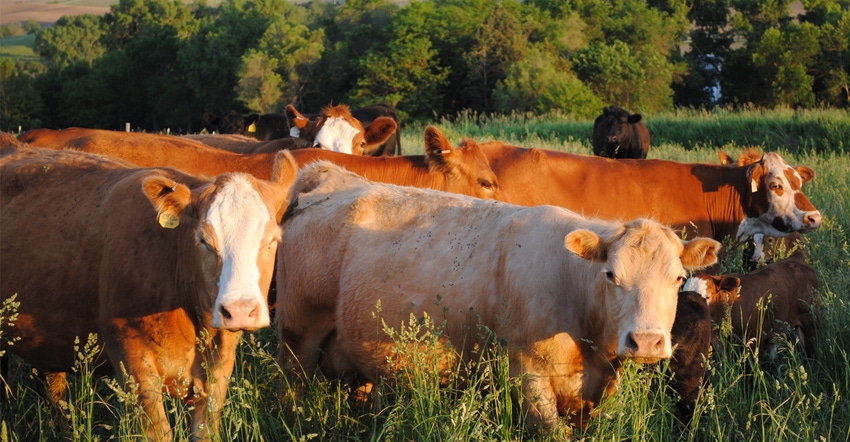
In August and September, flies are really bugging livestock. David Boxler, Nebraska Extension entomology educator, says that it isn’t that uncommon in September to notice several thousand flies buzzing around and landing on cattle.
At a recent Nebraska Extension stocker and yearling cattle workshop and tour near Nenzel, Neb., Boxler told cattle producers that late last summer, flies were a problem for livestock, and this year shapes up to be the same way.
There are three types of flies that hit cattle in Nebraska. Each type has its own distinct properties and offers its own challenges.
Horn flies
Horn flies are a continuous challenge for cattle producers. “It’s typical in late summer, particularly in September, to commonly see both sides of an animal with several thousand flies,” Boxler says. “The impact of these is significant.”
Horn flies have piercing mouthparts that are able to draw blood from the animal where they feed. “The horn flies develop in manure and have a high rate of movement among animals within the herd,” Boxler says. “The only time that they leave the animal is when the female leaves to deposit her eggs in fresh manure. Day and night, they are on the animal, and they feed during the night. They can feed up to 31 times a day.”
This can be a problem for producers, especially if they have a neighbor 3 or 4 miles away who does no fly control. “Flies generated in his pasture and manure, when they hatch, can move toward your cattle,” Boxler says. “They are also aided in migration by the wind.”
It is estimated that horn flies cause in excess of $1 billion in lost productivity on a national scale. “They have an impact on milk production and weaning weights, so it is significant for many of us to deal with,” Boxler explains. “Economic injury levels start to impact production of an animal when there are 200 flies on an animal. If you count the flies on each side of the animal, it doesn’t take many flies to reach economic injury level.”
While economic injury starts at 200 flies, it isn’t that unusual to see 3,000 flies per animal, especially in September. “If you had that kind of population on an animal for 90 days, the blood loss would be close to 1 gallon, so small amounts do add up,” Boxler adds.
Face flies
Historically, face flies have been more of a problem in eastern Nebraska, because of more moisture. “Our weather patterns change over time, give more rains and more changes,” Boxler says. “The Sandhills have been too dry historically, but we’re seeing that change now, and we might start to see this fly expand its range into the Sandhills.”
Because the female fly picks up proteins and takes her meals from the eye of the animal, her mouthparts can scarify the eye, and she can serve as a vector for pinkeye.
“That’s the issue with this fly,” Boxler says. “You have to bring an animal with pinkeye in to treat it, or give it multiple treatments, or the eye could ulcerate and the animal could lose the eye.”
Stable flies
Stable flies have been confined to south of the Platte River over the years. But, just like face flies, stable flies have expanded their region.
“If you see cows bunched up in the corners of pastures, stable flies are the cause of this,” Boxler says. “The flies feed on the legs and lower belly and cause a great deal of irritation.”
Animals continue to stomp and move closer together as a defense mechanism against stable flies. Stable flies are different from horn and face flies because they do not develop in manure, but rather in organic matter. Piles of old hay around round bale feeders, in wet debris or grass cuttings are prime spots for development.
As animals congregate to defend against stable flies, they can knock fences over. When cattle try to drink, stable flies hover above the water and continue to feed. After feeding on the animal, these flies seek shade.
If cattle rest in the shade of trees in the afternoon, it isn’t uncommon to hear the buzzing of stable flies resting on the underside of tree leaves, Boxler says. “You will see them on windmills and even on the underside of barbed wire,” he adds.
They disrupt grazing patterns and cost pounds of gain per day in the herd, Boxler says. “You commonly see 20 to 30 flies per leg on the animal, and that makes it difficult to treat,” he explains. “The methodology we use to control face and horn flies does not reach the leg area.”
Prevention is one of the best ways to control stable flies by spreading out old wet hay to dry it out and remove a prime area for their development. “Sanitation or moving the material out helps,” Boxler says. “There are also granular larvicides that you can sprinkle on the wet organic matter to reduce their numbers.”
To learn more about fly control and research, email Boxler at [email protected].
About the Author(s)
You May Also Like






